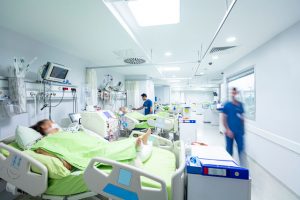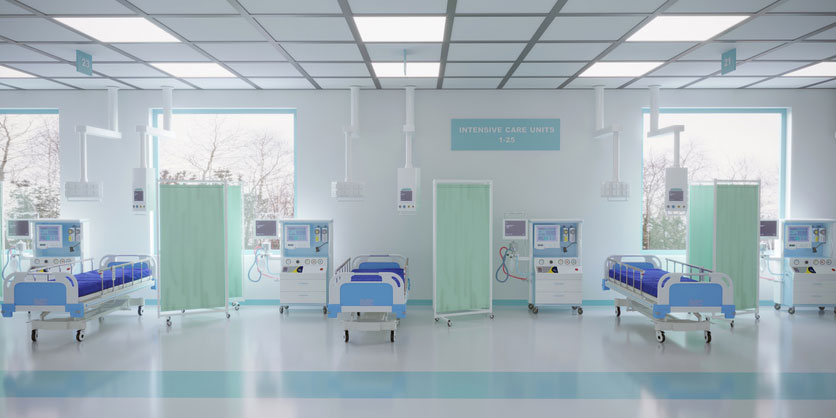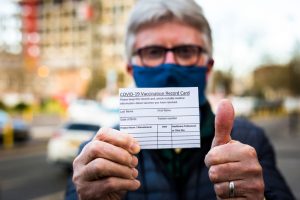Reviewed by Abbie Jacobs, RN, BSN
The COVID-19 pandemic has required workplaces and individuals to drastically change their lives, habits and how they do business. Perhaps no industry was more immediately impacted than hospitals and healthcare, and no workforce more heavily than nurses. Abbie Jacobs, RN, was one of those who experienced it firsthand.
Jacobs started her career as a trauma nurse in Reno, Nevada, before relocating to the Pacific Northwest. She’s now an emergency department nurse at PeaceHealth Cottage Grove Community Medical Center in Cottage Grove, Oregon.
“In the ER you see, well, you name it,” Jacobs says. “Everything from pediatric RSV [respiratory syncytial virus] to a mental health crisis to myocardial infarction—a heart attack.”
In Jacobs’ experience, COVID-19’s impact on the emergency department was immediate. “In terms of flow in the ER, our numbers dropped dramatically,” she says. “People seemed to be avoiding the ER for less emergent conditions.” It’s hard to say whether that was a good or bad thing, she adds.
And, like everywhere, the hospital was infused with a sense of uncertainty and fear when the pandemic first hit.
Jacobs says those feelings of destabilization have faded—but they’ve been replaced with a risk of burnout, especially among nurses. RNs are being asked to work lots of overtime, and policies and procedures are always changing, pushing the limits of an already highly adaptable workforce. Constantly wearing personal protective equipment (PPE), while vital for everyone’s safety, takes a physical toll as well.
While the ER is certainly a challenging place, Jacobs adds that it’s not the hardest-hit.
“The intensive care unit (ICU) and designated COVID units are most affected,” she says.
COVID-19 Testing and Safety Procedures for Hospitals
Are Nurses Getting Vaccinated Against COVID-19?
Delaying Medical Care: A Smart Choice, or a Risky One?
No. 1 Piece of Advice for Seeking Emergency Care During COVID-19
Help Prevent the Spread of COVID-19
COVID-19 Testing and Safety Procedures for Hospitals
 The testing procedures at PeaceHealth Cottage Grove consist of two tests: The rapid COVID test and the PCR. The rapid test is notorious for false positives, Jacobs says, so it’s used primarily for patients who are not suspected of having COVID-19. The PCR test is much more effective, but used to involve sending results out for analysis, resulting in wait times of up to three hours—which is just not sustainable in an emergency setting.
The testing procedures at PeaceHealth Cottage Grove consist of two tests: The rapid COVID test and the PCR. The rapid test is notorious for false positives, Jacobs says, so it’s used primarily for patients who are not suspected of having COVID-19. The PCR test is much more effective, but used to involve sending results out for analysis, resulting in wait times of up to three hours—which is just not sustainable in an emergency setting.
As the pandemic has progressed, more testing resources have moved in-house, and they can do the PCR test more often. “The longevity of the pandemic has shown that we need these resources,” Jacobs says.
Separate rooms in the ER are designated for COVID patients, and there’s a separate holding area for patients who come in with respiratory symptoms. Of course, due to the nature of COVID-19, some patients with no symptoms of the disease will turn out to have it. That’s why full PPE is required for all patient care, to protect both nurses and patients.
In the event that a COVID-19 patient has occupied a room or holding area intended for non-COVID patients, extra sanitation procedures are in place to protect non-infected patients and prevent spreading the virus within the hospital.
Are Nurses Getting Vaccinated Against COVID-19?
Jacobs has gotten vaccinated, as have most of her colleagues, she says. However, she stresses, “Nurses are people too, and some are waiting for more information. It’s a very personal choice.”
To anyone feeling uncertain about taking a vaccine, Jacobs encourages keeping an open mind and doing research using credible sources. The Centers for Disease Control and Prevention (CDC) is a good place to start. See their page about Ensuring COVID-19 Vaccine Safety in the U.S.
Delaying Medical Care: A Smart Choice, or a Risky One?
 At the beginning of the pandemic in early 2020, Jacobs saw a drastic decrease in emergency department attendance. Avoiding medical care was prevalent across the board, according to CDC, with an estimated 41% of U.S. adults delaying or avoiding medical care, including urgent or emergency care (12%) and routine care (32%), as of June 2020.
At the beginning of the pandemic in early 2020, Jacobs saw a drastic decrease in emergency department attendance. Avoiding medical care was prevalent across the board, according to CDC, with an estimated 41% of U.S. adults delaying or avoiding medical care, including urgent or emergency care (12%) and routine care (32%), as of June 2020.
“It’s a normal human thing, when there’s a pandemic, to avoid a doctor’s office with sick people,” Jacobs says. “But it depends what you’re putting off.”
It’s hard to say what’s truly nonessential. Jacobs’ advice is to trust your healthcare provider. If a doctor tells you something can be delayed, it’s OK to do so. But a disease can progress without you feeling it, so what seems nonessential may actually be crucial in the long run.
“If there’s a chance that a disease process is getting worse,” Jacobs says, “it’s best to get it checked out.”
If you’re concerned about safety practices at your doctor’s office or testing facility, call ahead to ask about their safety and cleaning protocols.
No. 1 Piece of Advice for Seeking Emergency Care During COVID-19
Jacobs’ advice for anyone who needs emergency care during the pandemic? It’s essentially the same advice as pre-pandemic: Be honest with your healthcare providers.
“It’s important to really tune into yourself and be honest about what your symptoms are,” Jacobs says. “If you have any drugs or alcohol in your system, we need to know about it. We’re not here to judge you—we only want to help.”
And rest assured that hospitals are going above and beyond to ensure patient safety, through ever-evolving procedures and sanitation protocols.
Overall, Jacobs feels very hopeful about things getting better from here.
“I think people masking, getting the vaccine, and avoiding hazardous situations is really helping” to keep numbers down, she said.
Help Prevent the Spread of COVID-19
Per CDC, here are the best practices for everyone to minimize the spread of COVID-19:
Get vaccinated. Make an appointment to get a vaccine as soon as you’re eligible for one.
Wear a mask. It should cover your nose and mouth completely, and be secured under the chin. Everyone 2 years and older should wear a mask in public or around people they don’t live with.
Keep your distance. In addition to masking, keep 6 feet of distance between yourself and people who don’t live with you. Inside your home, avoid close contact with people who are sick.
Avoid hazardous locations. That includes crowded spaces or places with low ventilation. Places where people take their masks down to eat, drink or exercise are even riskier.
Practice good hand hygiene. Wash your hand often using soap and water. Scrub for at least 20 seconds. This is especially important after you’ve been in a public space, after blowing your nose or sneezing, and before and after handling your mask. If soap and water aren’t available, use hand sanitizer that contains at least 60% alcohol.
Cover your coughs and sneezes. Cough or sneeze into your elbow or a clean tissue—not your hand—and throw used tissues in the trash immediately. Wash your hands often, especially after coughing or sneezing.
Clean and disinfect your home, car, and workplace often. Clean dirty surfaces immediately, and use disinfectant on clean surfaces. Here’s a list of disinfectants that kill the coronavirus from the United States Environmental Protection Agency.
Be aware of your health. Watch for COVID-19 symptoms like fever, cough, shortness of breath, loss of taste or smell and others. Make sure you have a thermometer at home as you can take your temperature if you suspect you have symptoms. Here’s a rundown of steps to take when you’re sick.





 Wear a mask. It should cover your nose and mouth completely, and be secured under the chin. Everyone 2 years and older should wear a mask in public or around people they don’t live with.
Wear a mask. It should cover your nose and mouth completely, and be secured under the chin. Everyone 2 years and older should wear a mask in public or around people they don’t live with.